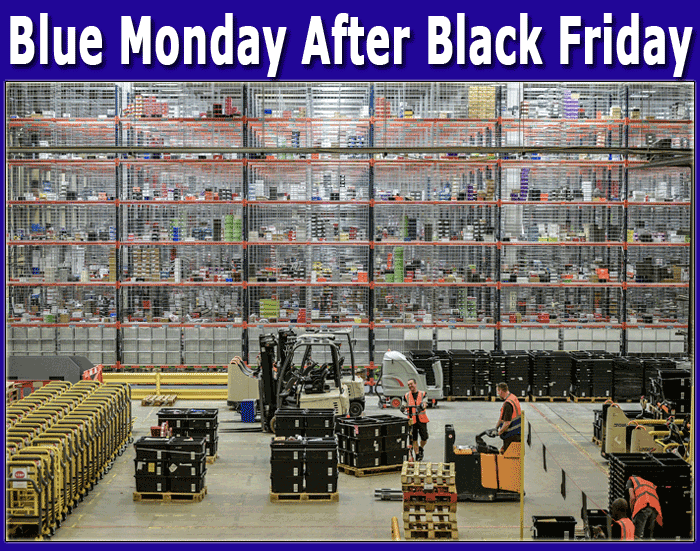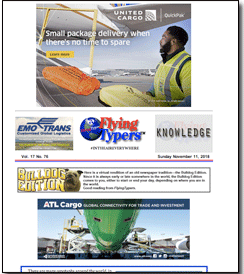
Workers move forklifts in front of huge
racks containing thousands of items at Amazon's fulfillment center
in Swansea, Wales, in the run up to Black Friday. |
Not likely! The peak season is well
and truly underway with November rates and volumes benefitting from the
slew of shopping festivals—Singles Day, Thanksgiving and Black Friday—rapidly
gaining in popularity and driving the acceleration of e-commerce shipments
even as retailers refresh inventories ahead of the traditional holiday
season.
Paralysis
By Analysis
U.S. markets are also caught in a sort of
frenzied paralysis due to expected increases of tariffs from 10% to 25%
on many imports from China on January 1, and the threat of even more tariffs
on Chinese products in the future. This has left shippers balancing the
pros and cons of when to ship Chinese goods based on their view of whether
the U.S.-China trade war will escalate, remain the same or an agreement
might be reached. This is called risk management by some; gambling by
most.
The TAC Index
Illustrating the contorted dynamism of air
cargo markets at present, TAC Index’s Hong Kong-North America ANP
(Actual Net Price - defined as the All in cost to carrier/Actual weight
on master AWB) reading on 12 November was $5.32 per kg, up from $4.45
per kg on October 15 and not far off the $5.56 per kg recorded on November
5, 2017, the highest price recorded by TAC Index over the last three years.
TAC Index’s China-Hong Kong to Europe basket
has also been gaining ground, reaching $3.18 per kg on November 12 from
a lowly 2.76 per kg on September 24.
Price Increases
Digital rates specialist Freightos noted
in mid-November that all three major air freight trade lanes had seen
price increases compared to the week starting November 5: Europe-U.S.
by 2%, and China-U.S. and China-Europe, both by 6%. “Air freight
prices are rising, following six months of near-static prices prior to
September,” it added.
On-the-ground reports from Flexport reflected
these trends. Ex-China rates to the U.S. were reported as “high”
with space tight and higher rates “expected to continue through
the next few weeks of peak season.” Ex-Hong Kong space was also
tight on “high” market demand.
Ex-Viet Noted
However, ex-Vietnam capacity was stable
with spot rates declining and no backlogs apparent.
One analyst hinted to FlyingTypers this
could be because U.S. importers are buying ‘Made in China’
products now ahead of tariff hikes, before potentially shifting purchases
to alternative production centers such as Vietnam, further down the line.
Time will tell.
U.S. China
Imports Up Ahead of January
 “Freightos
data shows recent increases in U.S. imports from China,” said Zvi
Schreiber, CEO, Freightos. “Paradoxically, they indicate that the
trade tariffs are driving increased Chinese imports in the short term. “Freightos
data shows recent increases in U.S. imports from China,” said Zvi
Schreiber, CEO, Freightos. “Paradoxically, they indicate that the
trade tariffs are driving increased Chinese imports in the short term.
“Even before September's big announcement,
the speed with which the first two rounds of tariffs were implemented
prompted many importers to immediately start stocking up.
“The January 1 tariff increase is still
spurring demand, but so too is the specter of tariffs soon being applied
to all remaining products.”
64 Dollar
Question is 2019
What happens to demand out of Asia in 2019
remains the critical question for air freight stakeholders, particularly
those active on the major East-West lanes. A number of carriers have recently
admitted that air cargo demand visibility on the Transpacific post-peak
and/or post-Chinese New Year is hard to forecast, given the multiple variables
related to tariffs now in play.
And, of course, this has repercussions for many other Asian origins, either
because they play a role in supplying parts to China or because they offer
non-tariff options for finished product sourcing, and might benefit from
higher tariffs on Chinese products.
 Boeing
Keeps Going Boeing
Keeps Going
More
long-term, the outlook is equally cloudy. “Aircraft manufacturer
Boeing has stated that over 2,600 new or converted freighters will be
needed over the 20 years to keep up with growing air cargo demand,”
said Nicola Hughes, an analyst with Freight Investor Services, an independent
inter-dealer broker.
“Boeing sees the growth in the China Express
market and the ever-expanding e-commerce market as leading this need for
extra capacity.
Singles Could
Be A Home Run
“Predictions from e-commerce specialist
Parcelhero support this, suggesting Singles Day will double in the UK
this year. As always, the relationship between demand and capacity was
a hot topic at TIACA: although Boeing projects huge growth long term,
in the immediate future this isn’t what we’re hearing.”
High &
Tight
And, as reported in FlyingTypers,
U.S. trade policy has thrown an additional curve ball to shippers in the
last month. “An added worry for online traders comes with Trump
pushing to leave the postal union in a bid to increase postal rates from
China to the West,” said Hughes.
“If rates are raised next year there could
be a strong push to send packages before any changes—whether capacity
is available at the time again comes into question.”
SkyKing
|




 Vol.
17 No. 76
Vol.
17 No. 76